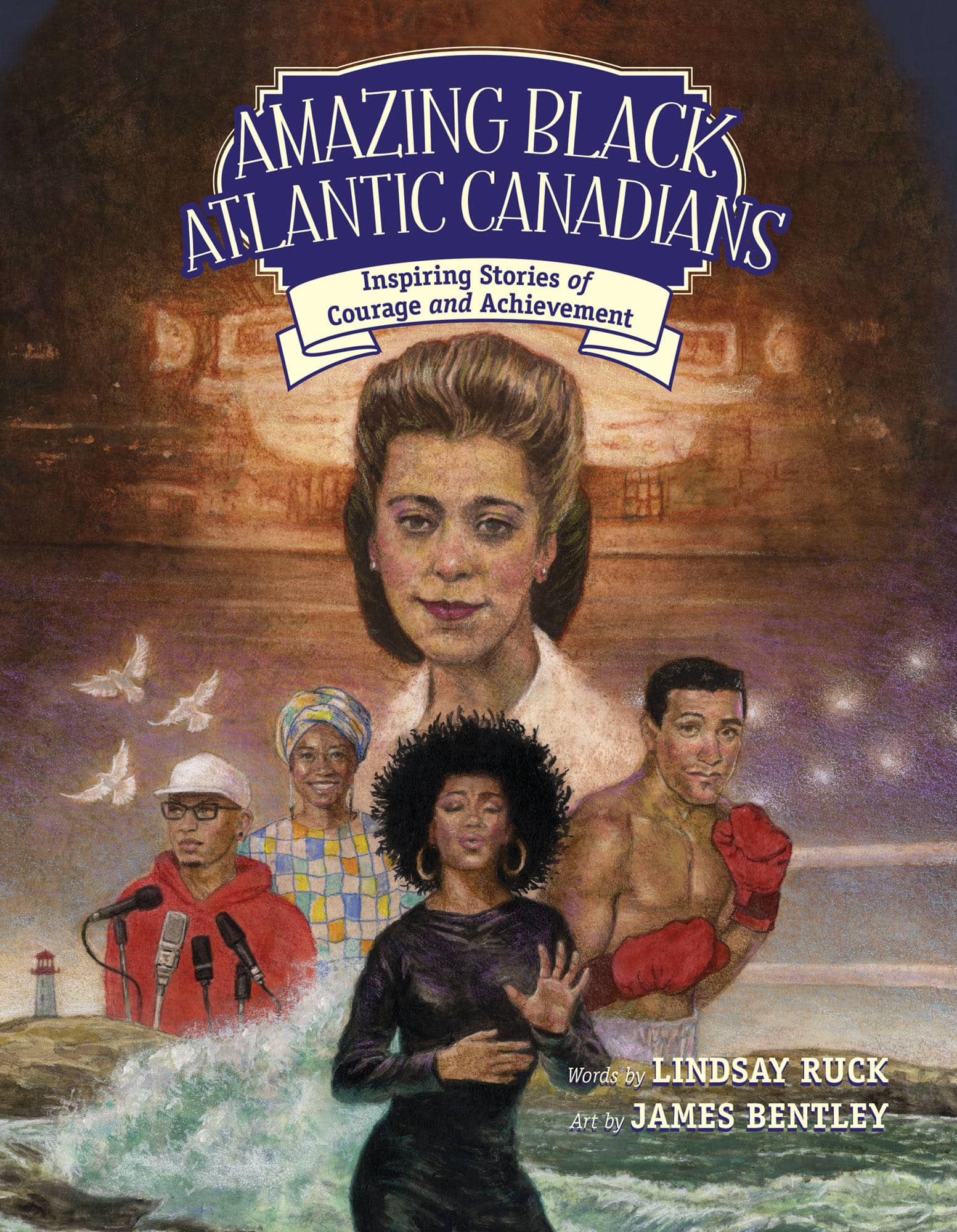
KJIPUKTUK (Halifax) – Lindsay Ruck didn’t learn her own history at school.
“When Black History Month – which it was called then – came around we talked a bit about Martin Luther King and touched on Rosa Parks,” says Ruck. “I was not learning about Viola Desmond or Lena O’Ree.”
The journalist and mother of two hopes to change that with Amazing Black Atlantic Canadians (Nimbus Publishing, $19.95), a captivating, full-colour, illustrated book profiling over 50 Black heroes and heroines with informative sidebars, an index and 20 portraits by Montreal artist James Bentley.
The individuals include sports heroes Rocky Johnson, father of Dwayne (The Rock) Johnson, and Olympic runner Marjorie Turner-Bailey; international opera star Measha Brueggergosman; activists Rocky Jones and Joan Jones; Corrine Sparks, the first Black female judge in Canada, and Ruck’s own grandfather, Calvin Ruck, a senator, social worker and human rights activist.
He was passionate about Black history and wrote Canada’s Black Battalion: No. 2 Construction, 1916–1920, a history of the Black veterans of the First World War.
“He was always keen to share stories,” says Ruck, who wrote her grandfather’s biography. “None of my friends knew what he was talking about. I am so grateful that I had a family that took an interest in Black history.”
She wants to inspire and empower youth through her subjects’ battles against racism and their willingness to take risks to pursue their talents or right a wrong.
Ruck’s own mentor was the late poet Maxine Tynes. “My mother brought me to a reading by Maxine Tynes at the Alderney Gate Public Library. I was captivated. That memory is so fresh – the way she strung words together so beautifully! I went home and I filled notebooks with poetry and ideas.
“I want people reading the book to say if they can do it so can I and that’s the way it happened when I saw Maxine,” says Ruck.
She dedicates the book, aimed at kids 8 to 12 but of great interest and import to teens and adults, to her children Georgia and Calvin.
“I want my kids to realize this isn’t just for my friends who are Black. This is for anyone who wants to learn about individuals who shaped Atlantic Canada today and Canada today. It’s our collective history and these individuals made a difference. It’s part of Canadian history.”
Ruck first approached Nimbus with an idea to do a children’s book on the Black Battalion. Nimbus suggested “we take it one step forward” to publish a second book in its Amazing Atlantic Canadians series. The first was Amazing Atlantic Canadian Kids by John Boileau with images by Bentley.
“There is a huge void when it comes to literature especially for kids on Black Atlantic Canadians,” says Ruck.
The research was extensive with a lot of digging online and in libraries. She contacted archives and historical groups to find interesting anecdotes and pin down facts for concise and valuable histories of Black settlement going back as far as translator Mathieu da Costa in the 1600s and Louisbourg tavern owner Marie Marguerite Rose in the 1700s.
The process of selection was also difficult. “The Atlantic provinces are bursting with amazing Black Atlantic Canadians. This could be multiple volumes.”
A discovery for her was Lena O’Ree who, at 17, was the first Black radio announcer in Saint John, N. B. The station did not tell listeners she was Black.
In the 1950s Lena was a housekeeper at the Admiral Beatty Hotel.
As Ruck writes: “All guests, including Black celebrities like Louis Armstrong and Ella
Fitzgerald, had to use the back door. Once Lena learned of this rule, she refused to show up for her shift until she was allowed to go through the front door. Lena’s protest made national headlines and eventually the rule was changed and the colour barrier was removed from the Canadian Pacific Hotels chain across the country. Thanks to Lena, Black guests were also allowed to sit in the hotel dining rooms.”

Ruck also records her grandfather’s battles against racism. He fought the barbershop that wouldn’t cut his kids’ hair because they were Black. He also fought to build a house in a Dartmouth neighbourhood that didn’t want him.
“Many signed a petition to stop him. They thought that he’d build a substandard house.” Once the Ruck family moved in they received hate mail and phone calls. “Some people would have gotten out of there. He was so determined to stay in the neighbourhood. That wasn’t that long ago.”
There are a lot of firsts in this book, some of them amazingly recent, says Ruck, pointing to Paul Growns and Jevaughn Coley, who became the first Black police officers of the nearly 300-year-old Royal Newfoundland Constabulary in 2019. “I find that shocking. It tells me how much work there is still to be done.
“These stories are amazing and people don’t know about them. I’d love to expand on this and grow it and add on down the road.”
She put her father, Douglas Ruck, a lawyer and the first Black ombudsman of Nova Scotia, in the book next to his father’s profile, without telling him.
“I have the family to dinner every Friday night. I handed a copy to my grandmother and one to my father and I said, ‘You can find Granddad’s page right here,’ and I thought, ‘Does he not see his own name?’
“He stared for a moment and was extremely touched. What he’s done in life is amazing and he has taught me so much – to keep your head high and to go against the grain if people are trying to shut you down because of your race. He’s the reason I have pride in being a Black woman, a biracial woman.”
See also: Wayne Desmond: Whose shoulders I stand on – New Glasgow’s rich Black heritage
Check out our new community calendar!
With a special thanks to our generous donors who make publication of the Nova Scotia Advocate possible.
Subscribe to the Nova Scotia Advocate weekly digest and never miss an article again. It’s free!




Great stuff Grew up in new glasgow
I recently finished Water Dancer, by Ta-Nehisi Coates (Random House Books;2019), an exquisitely mystical and very moving account of the Underground Railroad. It describes the life of an escaped American slave and the emotional turmoil of escaping slavery. It moved me deeply and I recommend it highly. Two black Nova Scotians that come to mind for me are Olympic runner Marjorie Bailey and American/Canadian artist James Shirley, a friend and once neighbour and friend of mine in Cape Breton. Jim, originally from NY city, was very active in the NS black rights movement in the seventies. Thank you for the article Ellisa and thank you Lindsay Ruck for calling attention to these outstanding Nova Scotians. I hope that the book will find its way to inspire students in all school libraries across the province.